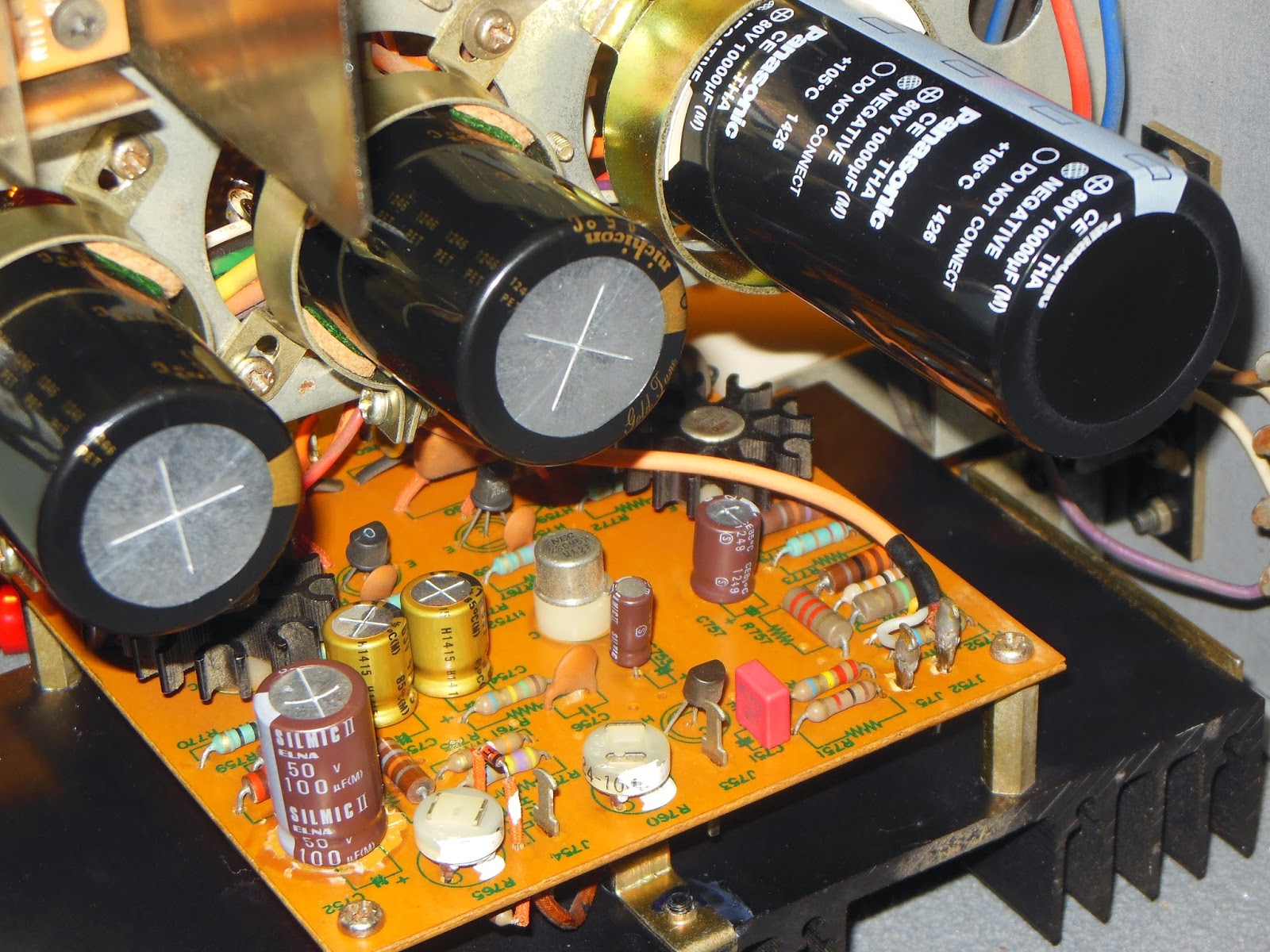Marantz Model 30Grabbed this for my personal use, got lucky a bit; this particularity model having a serial of 1640! The Power supply, relay and amplifier boards are all very similar to the model 15. 32 and model 33 pre amplifier. Originally these use 2 channel moto outputs, very robust unit at 120W total RMS.
Im really a huge fan of symmetric isolated board topographies, and the assemble is very straightforward with most boards or clamps being fairly easy to access along with test points. the only major draw back was the U shaped chassis, which doesnt allow you to remove the back panel as its a folded chassis.
This unit had suffered a catastrophic cascade failure of the amplifier channel, protect and PS boards. Heres an outline to my method.
The primaries and secondaries are not shorted so we add first the the power supply board to the primaries;
At the power supply pin 1 and 9 were noted to have crisped traces causing intermittent connection, Along with C404/405 venting excessively.
The Diodes CR401-404 are all general purpose 1.5a rectifier diodes. Q401/402 I believe helps regulate CR401-404 diode bridge. The manual states
zeners CR405/406 are the voltage references for the two transistors. All the transistors and diodes were updated and the electrolytics replaced with
quality axials.
CR401/404 1.5a rectifier (512-1N5393) IN5393 equivalent (common)
CR405/406 18V 500mW zener (833-1n5248B-TP) IN967A equivalent (common)
Q401 BJT NPN (512-KSC2690AYS) SPS2219 equivalent
Q402 BJT PNP (512-KSA1220AYS) SOS2220 equivalent
c401/408 500uf 25v
C404/405 100uf 50V
C409-412 680uf 63V
Next lets add the relay rail back to the circuit. Which is when it started to trip my DBT again. On the relay an uber common fail point is the bridge rectifier CR301, which was shorted across the AC/AC and a bridge rectifier is basically 4 one way diodes together so. The relay would also not engage,
and the manual notes diodes CR302/303 which are also general purpose 1.5a rectifiers control the positive voltage for the relay. They tested okay but the relay had heavy signs of carbon build up and what looks like arching. along with the shorted bridge would explain why the carbon comps at R307/308/311 were damn near burnt.These three resistors were changed to small 5W wirewounds. Q302 BJT transistor is a common Moto SS47. Q301/303 are both NPN BJT SPS439 transistors. Q301 I believe is a protection in case a voltage of excessive voltage, which shorts Q303. (excessive draw) The relay K301 can be replace with a standard available omron with the documented coil/contact conversion. thier are three main lytics two change here, one value is kinda tricky to assemble, you will probably have to put two capacitors in series.
K301 OMRON MY-02 24VDC
Q301/303 BJT NPN (512-BC546ABU) SPS439 equivalent
Q302 BJT NPN (MJE182STU) moto SS47 equivalent (common)
CR302/303 1.5a rectifier (512-1N5393) IN5393 equivalent (common)
R307/R308 1.5k 5W
R311 150ohm 5W
C301 33uf 16v
c302 125uf 25V
C303 10uf 100V
C3/4 Filter Caps 6800uf 50V screw type (565-3328-ND)
Okay so now on the DBT I had no shorts with the power and relay boards in, lets add the right board that I presume works. and the DBT confirms at least no shorts. Now we can add and remove the channels
while testing or making final adjustments very easily on this model. by removing the red/blues rails from each channel to the large filters caps C3/C4 capacitors.
Okay I added back the left channel and the dbt indicated a short. Now this channel already had been worked on by a mystery slob, the ouputs had been replaced and the foil side of
the pcb was a damn mess. half the job on this board was repairing broken eyelets and traces. Now afer talking with some people we theorize the only way to achieve as much damage
as this board did was to be overdriven to the extreme, were talking 4 shorted transistors galore. What ended up being easiest for this board was to pull all of the zener, diodes, transistors and replace the lytics.
Now a guy could slowly add back and fourth confirmed transistors from the right side but thats a good way to fry something else down the line. IMHO if I narrowed it down to the channel...whats a half
hours work pulling components and testing? nothing.
For starters the input signal comes into the Amp in, theres the Q202/201(MPSA09) differential/inverter stage which Q202 was shorted at (c-e), and then the inverter output is applied to the predrivers Q206/208 which are the common BJT MPSA20/70
counter parts both of which were shorted (c-e). this output from Q206(ss48)/208(SS47) is applied to the Q209/210 drivers which in turn power the outputs Q1/Q2 (SJ2046/2047). Q207(MPSA20) was also shorted (c-e). R245/R213 were upgraded to carbon Films
and the lytics at C201/201 were upgraded to FG's, along with a new axial at c209.
Q201/202 MPSA09
Q204 MPSA70
Q205/207 MPSA20
Q203/206 (MJE172STU) moto SS48 equivalent (common)
Q208 (MJE182STU) moto SS47 equivalent (common)
C201/203 10uf 16v
c209 47uf 16v
Q1 MJ21195G(PNP) SJ2047 moto equivalent
Q2 MJ21196G (NPN) SJ2046 moto equivalent
Power switch is a standard EG1018-ND 7a 125V DPDT with a X1Y2 safety cap, though it will take much modification to make it fit proper.
Also added was a new power cord and rear input/output RCA terminals, along with new speaker terminals. The manual call for use of a Watt meter for the BIAS but using a DMM
across collectors of Q1/Q2 you can adjust R224 pot for Bias, or the across the emitter resistors R230/231 and adjusting R224 pot. The manual does call for a load when doing these adjustments.
N.S.


































.JPG)


















